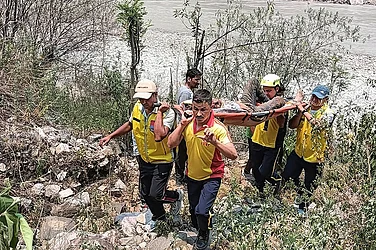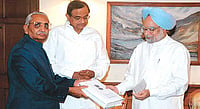The Congress government’s development schemes in rural areas have found some resonance. The only advantage that former chief minister N. Chandrababu Naidu seems to enjoy derives from an unlikely alliance with the Telangana Rashtra Samiti (TRS) and the Left. The TRS demands a separate state of Telangana, while the Left parties have traditionally been hostile to the idea. Their coming together might signal short-term political pragmatism, but the alliance is certain to come under severe strain after the elections. The TRS went with the Congress in 2004 and its alliance with the TDP will afford the latter some electoral benefits in Telangana. The Left also has pockets of support in the region, and together, the Grand Alliance is certain to put pressure on the Congress there.
In the rest of the state, especially in Andhra and Rayalaseema, the contest will be a three-cornered one between the Congress, the Grand Alliance and the PRP. Chiranjeevi’s party has come to articulate the aspirations of the Kapu community, the single largest community in AP, who have, for long, resented the dominance of the Kamma community represented by the TDP and its leadership. Traditionally with the Congress, the Kapus are certain to vote for the PRP. The PRP has not been free of troubles either. Its lack of an organisational structure, recent desertions by senior members and mismanagement in ticket distribution has compounded its woes. Some dissatisfied Kapu voters are likely to return to the Congress fold, but their numbers might not be considerable. The Kamma vote deserted the TDP in 2004, but the PRP’s emergence is likely to bring them back to vote for the TDP, especially in southern AP and in pockets of its stronghold in coastal districts. But despite implosions within the PRP, it is likely to get a sizable chunk of the Kapu votes.
In such a scenario, the TDP will improve upon its disastrous performance of 2004, when it was reduced to 47 seats in the 294-member house. Since 2004, Chandrababu Naidu, once christened the CEO of Andhra Pradesh and the poster boy of corporate India, has found an abiding love for the poor. Taking a populist leaf from N.T. Ramarao’s book, he has announced schemes that include subsidised rice, free electricity for farmers, TV sets, and a Brazil-inspired model of direct cash transfers to the poor. It is difficult to say if anything other than the caste factor along with the marginal advantage of cobbling together an alliance is going to help Naidu to regain the chief ministerial office.
The Congress is unlikely get a majority despite Y.S. Rajasekhara Reddy’s charisma and his focus on rural areas. The opposition in the state had hoped that the Satyam scam would affect the CM, but typically, corruption refuses to emerge as an election issue either in the state or in the country. The Congress cannot hope to repeat its 2004 performance of winning 185 seats on its own, and has no allies of any consequence. In the likelihood of a hung assembly, it will have to turn to the PRP for support, with Chiranjeevi the likely kingmaker. There is little chance of the PRP supporting the TDP. The other national party in the state, the bjp, has little presence: it won two seats in 2004.
Congressmen in the state are secretly not unhappy with such a scenario. They are hoping that a reversal in fortunes might cut YSR’s sway over the state’s affairs and his hold over the Congress highcommand. There is also some discomfort regarding the rise of Jagan Reddy, the CM’s controversial son; a diluted mandate for the Congress might help rein in his rising power. In any case, the Andhra Pradesh assembly elections are unlikely to throw up a dramatic result.
(The writer is professor of political science at the University of Hyderabad.)
























